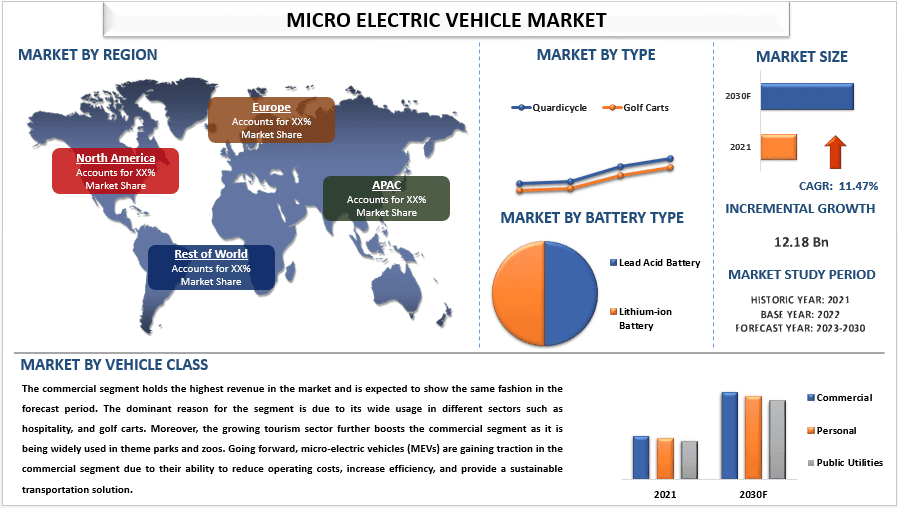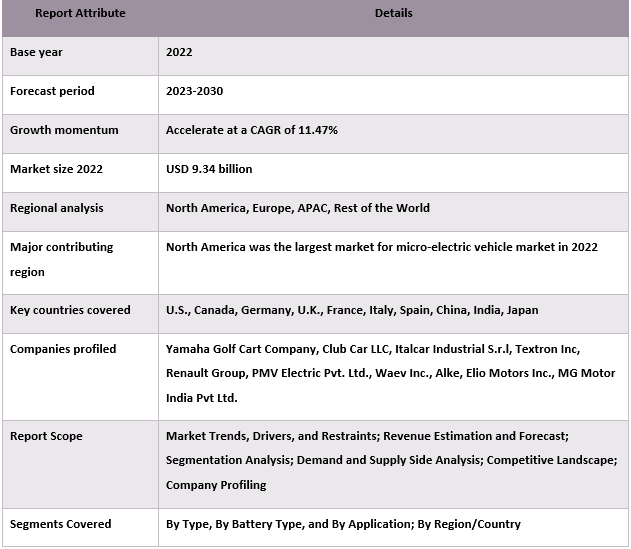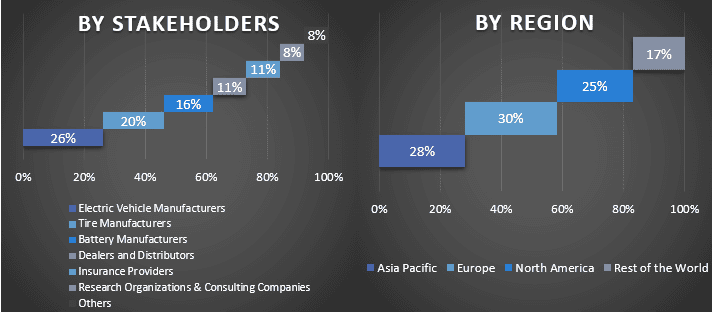- Home
- About Us
- Industry
- Services
- Reading
- Contact Us
Micro Electric Vehicle Market: Current Analysis and Forecast (2023-2030)
Emphasis on Type (Quadricycle and Golf Carts); Battery Type (Lead-acid Battery and Lithium-ion Battery); Application (Commercial, Personal, and Public Utilities); and Region/Country

According to a new report by Univdatos Market Insights, The Global Micro Electric Vehicle Market Globally is expected to reach USD 21.52 Million in 2030 by growing at a CAGR of 11.47% in Forecasted Period (2023-2030). The micro-electric vehicle market is growing rapidly due to a combination of factors, including changing consumer behavior, evolving government regulations, and the rapid launch of new models in the market. As more people grow to be aware of the environmental impact in their daily activities, they are looking for alternative modes of transportation that can be cleaner and more sustainable. MEVs fit perfectly into this narrative, offering a low-cost, low-maintenance alternative for those who want to reduce their carbon footprint without sacrificing convenience. According to a study by the International Energy Agency (IEA), the global passenger car fleet could reach 8 billion vehicles by 2050, with most of them being electric or hybrid vehicles. This shift towards electrification is primarily driven by changes in consumer behavior, as well as government policies and technological advancements. Going forward, governments around the world have implemented policies to reduce greenhouse gas emissions from transportation, such as tax breaks, subsidies, and registration fees for electric vehicles, enabling MEVs to compete with conventional vehicles. For instance, in China, the government has announced plans to ban all gasoline-powered vehicles from the capital city of Beijing by 2030, to reduce pollution and promote clean energy. This move has led to a significant increase in demand for MEVs in China, with many local automakers already producing electric versions of their existing models.
Some of the major players operating in the market include Yamaha Golf Cart Company, Club Car LLC, Italcar Industrial S.r.l, Textron Inc, Renault Group, PMV Electric Pvt. Ltd., Waev Inc., Alke, Elio Motors Inc., MG Motor India Pvt Ltd. Several M&As along with partnerships have been undertaken by these players to facilitate customers with hi-tech and innovative products/technologies.
Insights Presented in the Report
“Amongst types, the golf carts segment generates the highest revenue in 2022.”
Based on type, the market is bifurcated into quadricycle and golf carts. The golf carts segment generates the highest revenue in 2022 and is expected to show the same fashion in the forecast period. The segment has the maximum revenue due to its wide range of applications. Golf carts are used in golf courses, hotels & resorts, airports, industrial facilities, and other areas. Moreover, the product launched is the key development strategy to keep pace with the changing demands of end users. For instance, Textron Specialized Vehicles introduced the Hauler Pro LSV and Tour LSV, two new Cushman utility models, and Toro introduced Vista, the golf cart-like shuttles for golf courses, resorts, and large campuses.
“Amongst battery types, the lithium-ion battery segment dominated the market in 2022.”
Based on battery type, the market is bifurcated into lead-acid batteries and lithium-ion batteries. The lithium-ion battery segment dominated the market in 2022 and is expected to showcase the same trend in the forecast period. The segment dominated due to the rising adoption and demand for electric vehicles. Moreover, lithium-ion batteries have a higher density compared to lead-acid batteries, they can store more energy per unit of weight and volume. Going forward, lithium-ion batteries have a longer life span compared to other types of batteries, lasting thousands of charge cycles before losing their capacity. This means that EVs equipped with lithium-ion batteries can drive for many years without requiring expensive replacements. Moreover, the cost of lithium-ion batteries has decreased dramatically in the last couple of years due to the ongoing advancement in battery technology.
Amongst applications, the commercial segment holds the highest revenue in 2022.”
Based on the application, the market is divided into commercial, personal, and public utilities. The commercial segment holds the highest revenue in the market and is expected to show the same fashion in the forecast period. The dominant reason for the segment is due to its wide usage in different sectors such as hospitality, and golf carts. Moreover, the growing tourism sector further boosts the commercial segment as it is being widely used in theme parks and zoos. Going forward, micro-electric vehicles (MEVs) are gaining traction in the commercial segment due to their ability to reduce operating costs, increase efficiency, and provide a sustainable transportation solution. The trend of corporate social responsibility and the increasing focus on sustainability is also driving the adoption of electric vehicles in the commercial segment.
“North America was the largest market for micro-electric vehicle market in 2022.”
The North American region witnessed the largest market for micro-electric vehicles. This can be attributed to several factors, including government initiatives, increasing environmental concerns, and changing consumer preferences. Moreover, the region witnessed a higher number of golf carts and golf courses. Going forward, the government in the region will play an important role in the adoption of electric vehicles by providing substantial incentives and rebates. For example, California offers a USD 10,000 rebate for buyers of zero-emission vehicles, while Washington provides a USD 2,500 rebate. Such incentives have helped to create a conducive environment for the growth of the micro-electric vehicle market.
Micro Electric Vehicle Market Report Coverage

Reasons to buy this report:
- The study includes market sizing and forecasting analysis validated by authenticated key industry experts.
- The report presents a quick review of overall industry performance at one glance.
- The report covers an in-depth analysis of prominent industry peers with a primary focus on key business financials, product portfolios, expansion strategies, and recent developments.
- Detailed examination of drivers, restraints, key trends, and opportunities prevailing in the industry.
- The study comprehensively covers the market across different segments.
- Deep dive regional level analysis of the industry.
Customization Options:
The global micro-electric vehicle market can further be customized as per the requirement or any other market segment. Besides this, UMI understands that you may have your own business needs, hence feel free to contact us to get a report that completely suits your requirements.
Table of Content
Research Methodology for the Micro Electric Vehicle Market Analysis (2023-2030)
Analyzing the historical market, estimating the current market, and forecasting the future market of the global micro-electric vehicle market were the three major steps undertaken to create and analyze the adoption of micro-electric vehicles in major regions globally. Exhaustive secondary research was conducted to collect the historical market numbers and estimate the current market size. Secondly, to validate these insights, numerous findings and assumptions were taken into consideration. Moreover, exhaustive primary interviews were also conducted, with industry experts across the value chain of the global micro-electric vehicle market. Post assumption and validation of market numbers through primary interviews, we employed a top-down/bottom-up approach to forecasting the complete market size. Thereafter, market breakdown and data triangulation methods were adopted to estimate and analyze the market size of segments and sub-segments of the industry pertains to. Detailed methodology is explained below:
Analysis of Historical Market Size
Step 1: In-Depth Study of Secondary Sources:
Detail secondary study was conducted to obtain the historical market size of the micro-electric vehicle market through company internal sources such as annual reports & financial statements, performance presentations, press releases, etc., and external sources including journals, news & articles, government publications, competitor publications, sector reports, third-party database, and other credible publications.
Step 2: Market Segmentation:
After obtaining the historical market size of the micro-electric vehicle market, we conducted a detailed secondary analysis to gather historical market insights and share for different segments & sub-segments for major regions. Major segments are included in the report as type, battery type, and application. Further country-level analyses were conducted to evaluate the overall adoption of testing models in that region.
Step 3: Factor Analysis:
After acquiring the historical market size of different segments and sub-segments, we conducted a detailed factor analysis to estimate the current market size of the micro-electric vehicle market. Further, we conducted factor analysis using dependent and independent variables such as type, battery type, and application of the micro-electric vehicle market. A thorough analysis was conducted for demand and supply-side scenarios considering top partnerships, mergers and acquisitions, business expansion, and product launches in the micro-electric vehicle market sector across the globe.
Current Market Size Estimate & Forecast
Current Market Sizing: Based on actionable insights from the above 3 steps, we arrived at the current market size, key players in the global micro-electric vehicle market, and market shares of the segments. All the required percentage shares split, and market breakdowns were determined using the above-mentioned secondary approach and were verified through primary interviews.
Estimation & Forecasting: For market estimation and forecast, weights were assigned to different factors including drivers & trends, restraints, and opportunities available for the stakeholders. After analyzing these factors, relevant forecasting techniques i.e., the top-down/bottom-up approach were applied to arrive at the market forecast for 2030 for different segments and sub-segments across the major markets globally. The research methodology adopted to estimate the market size encompasses:
- The industry’s market size, in terms of revenue (USD) and the adoption rate of the micro-electric vehicle market across the major markets domestically
- All percentage shares, splits, and breakdowns of market segments and sub-segments
- Key players in the global micro-electric vehicle market in terms of products offered. Also, the growth strategies adopted by these players to compete in the fast-growing market.
Market Size and Share Validation
Primary Research: In-depth interviews were conducted with the Key Opinion Leaders (KOLs) including Top Level Executives (CXO/VPs, Sales Head, Marketing Head, Operational Head, Regional Head, Country Head, etc.) across major regions. Primary research findings were then summarized, and statistical analysis was performed to prove the stated hypothesis. Inputs from primary research were consolidated with secondary findings, hence turning information into actionable insights.
Split of Primary Participants in Different Regions

Market Engineering
The data triangulation technique was employed to complete the overall market estimation and to arrive at precise statistical numbers for each segment and sub-segment of the global micro-electric vehicle market. data was split into several segments & sub-segments after studying various parameters and trends in the areas of type, battery type, and application in the global micro-electric vehicle market.
The main objective of the Micro Electric Vehicle Market Study
The current & future market trends of the global micro-electric vehicle market were pinpointed in the study. Investors can gain strategic insights to base their discretion for investments on the qualitative and quantitative analysis performed in the study. Current and future market trends determined the overall attractiveness of the market at a regional level, providing a platform for the industrial participant to exploit the untapped market to benefit from a first-mover advantage. Other quantitative goals of the studies include:
- Analyze the current and forecast market size of the micro-electric vehicle market in terms of value (USD). Also, analyze the current and forecast market size of different segments and sub-segments.
- Segments in the study include areas of the type, battery type, and application.
- Define and analyze the regulatory framework for the micro-electric vehicle
- Analyze the value chain involved with the presence of various intermediaries, along with analyzing customer and competitor behaviors of the industry.
- Analyze the current and forecast market size of the micro-electric vehicle market for the major region.
- Major countries of regions studied in the report include Asia Pacific, Europe, North America, and the Rest of the World
- Company profile of the micro-electric vehicle market and the growth strategies adopted by the market players to sustain in the fast-growing market.
- Deep dive regional level analysis of the industry
Related Reports
Customers who bought this item also bought










